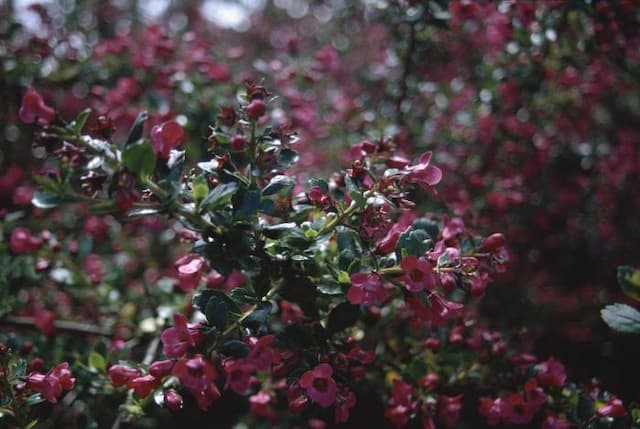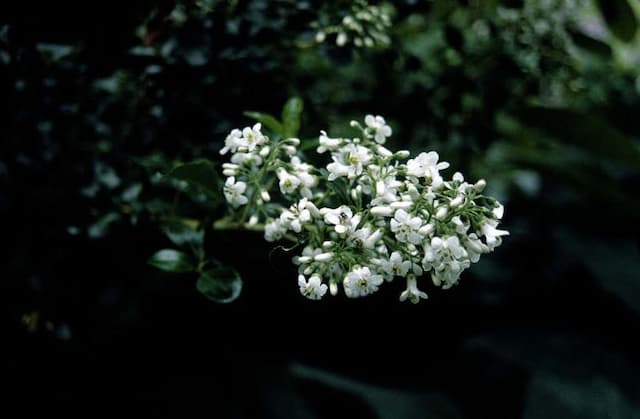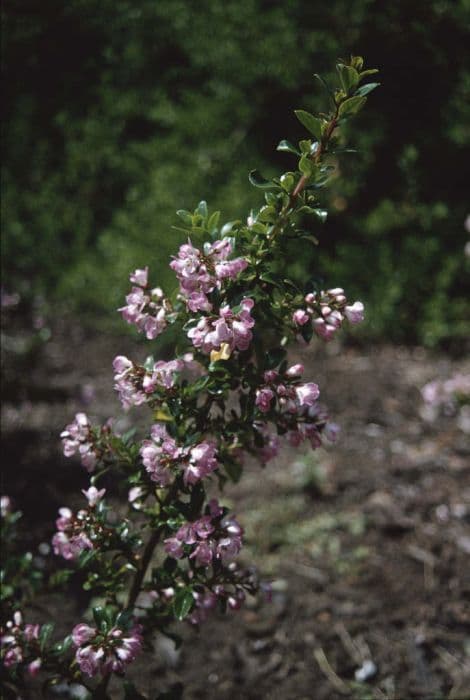Gold Brian Escallonia Escallonia laevis 'Gold Brian'

ABOUT
Escallonia laevis 'Gold Brian', commonly known as Escallonia 'Gold Brian', is a stunning evergreen shrub with distinctive foliage and striking flowers. The leaves present a vibrant, golden-yellow hue that adds a bright, eye-catching element to the garden throughout the year. They are small, glossy, and have a slightly toothed edge, which gives them a fine texture. Flowering usually occurs in the warmer months, when 'Gold Brian' produces clusters of petite flowers. These blooms are typically pink, forming a delightful contrast with the golden foliage. Their tubular shape is attractive to a variety of pollinators, including bees and butterflies, which find them particularly appealing. Overall, Escallonia 'Gold Brian' has a bushy and dense habit, displaying its foliage and flowers with a lush appearance that makes it an ideal choice for gardeners looking to add a splash of color and texture to their landscape. Its evergreen nature ensures that it remains a focal point of interest throughout all seasons.
About this plant
 Names
NamesFamily
Escalloniaceae.
Synonyms
Gold Brian Escallonia, Golden Escallonia.
Common names
Escallonia laevis 'Gold Brian'.
 Toxicity
ToxicityTo humans
Escallonia is not commonly known for its toxicity to humans. While most parts of the plant are unlikely to cause severe poisoning, it is always possible for individuals to have allergic reactions or sensitivities to plant materials. In general, if any part of an Escallonia plant is ingested, it is not expected to cause more than mild stomach upset, if any symptoms occur at all. However, it is advisable to exercise caution and keep plants out of the reach of small children who may put parts of it in their mouth.
To pets
Escallonia is not known to be toxic to pets. It does not appear on lists of poisonous plants for animals such as dogs and cats. If a pet were to ingest a part of the Escallonia plant, it is not likely to result in serious poisoning. As with humans, mild gastrointestinal upset could possibly occur, especially if a pet eats a large amount of the plant material. However, every animal can react differently to various plants, and individual sensitivity or allergic reaction could occur. It is always best to prevent pets from ingesting plants not intended for their consumption.
 Characteristics
CharacteristicsLife cycle
Perennials
Foliage type
Evergreen
Color of leaves
Varied
Flower color
Pink
Height
6-8 feet (1.8-2.4 meters)
Spread
4-6 feet (1.2-1.8 meters)
Plant type
Shrub
Hardiness zones
8-10
Native area
South America
Benefits
 General Benefits
General Benefits- Ornamental Value: Escallonia 'Gold Brian' is known for its attractive foliage and clusters of pink flowers, which add aesthetic appeal to gardens and landscapes.
- Habitat for Wildlife: The flowers provide nectar for pollinators such as bees and butterflies, supporting local ecosystems.
- Low Maintenance: It is considered to be a low-maintenance plant that doesn't require frequent care, making it suitable for gardeners of all levels.
- Drought Tolerance: Once established, Escallonia 'Gold Brian' is drought-resistant, reducing the need for constant watering.
- Privacy and Screening: With its dense growth habit, this plant can be used for creating privacy hedges or screens in gardens and yards.
- Windbreak: Its sturdy nature makes it suitable for use as a windbreak, providing protection for gardens against strong winds.
- Erosion Control: The plant’s root system can help stabilize soil and prevent erosion, especially on slopes.
- Coastal Planting: Escallonia 'Gold Brian' is salt tolerant, making it an excellent choice for coastal areas where saline conditions can be problematic for other plants.
 Medical Properties
Medical PropertiesThis plant is not used for medical purposes.
 Air-purifying Qualities
Air-purifying QualitiesThis plant is not specifically known for air purifying qualities.
 Other Uses
Other Uses- Escallonia can be used as a natural dye source. The leaves and flowers might give varying shades depending on the mordant used.
- Because of its dense foliage, Escallonia is suitable for creating privacy hedges or garden borders.
- Escallonia wood can be used in small woodworking projects due to its hardness and texture.
- Its nectar-rich flowers are ideal for encouraging pollinators such as bees and butterflies into the garden.
- Can be used in coastal areas to prevent soil erosion owing to its robustness against salty winds.
- Gardeners can utilize the plant's distinctive foliage for contrast in mixed floral arrangements.
- The fast-growing nature of Escallonia makes it an ideal candidate for covering unsightly fences rapidly.
- Its durability allows it to be used as a windbreak in exposed or high-altitude gardens.
- Can be shaped into topiary forms for decorative garden features or maze designs in large gardens.
- When dried, the leaves of Escallonia can be used to create a natural potpourri. The leaves may retain a subtle fragrance and add a rustic appeal to a room.
Interesting Facts
 Feng Shui
Feng ShuiThe Escallonia is not used in Feng Shui practice.
 Zodiac Sign Compitability
Zodiac Sign CompitabilityThe Escallonia is not used in astrology practice.
 Plant Symbolism
Plant Symbolism- Endurance: Escallonia, in general, is a hardy shrub that can endure a variety of growing conditions, representing the ability to withstand challenges and persist through difficulties.
- Protection: Known for its dense foliage, Escallonia is often used as a hedge or border plant, symbolizing a barrier against negative forces and providing a symbolic sense of safety and protection.
- Adaptability: The versatility of Escallonia in landscaping reflects adaptability, as it thrives in coastal as well as inland areas, indicating the capacity to adjust to changing environments or situations.
 Water
WaterGold Brian Escallonias prefer consistently moist but well-drained soil. Water the plant thoroughly once a week, allowing the water to penetrate deep into the soil, encouraging strong root development. Increase watering to twice per week during periods of extreme heat or dry spells. Each watering session should provide the Gold Brian with about 1 to 1.5 gallons of water. During the fall and winter, reduce the amount of water as the plant's growth slows down.
 Light
LightGold Brian Escallonias thrive in full sun to partial shade. The ideal location is a spot where the plant can receive at least four to six hours of direct sunlight daily. If in a particularly hot climate, providing afternoon shade can help protect the plant from excessive heat stress.
 Temperature
TemperatureGold Brian Escallonias can tolerate a wide range of temperatures, but they perform best in temperatures ranging from 50°F to 75°F. They can survive in temperatures as low as 20°F and as high as 90°F; however, prolonged exposure to extremes can stress the plant. Ensure protection from frost to avoid damage to the foliage and stems.
 Pruning
PruningPrune Gold Brian Escallonias to maintain shape and encourage dense growth, usually once a year in late winter or early spring before new growth starts. Remove any dead, damaged, or diseased branches, and trim back a third of the older stems to stimulate fresh growth. Pruning can also be done after flowering to shape the plant or reduce its size.
 Cleaning
CleaningAs needed
 Soil
SoilThe best soil mix for a Golden Escallonia (Escallonia laevis 'Gold Brian') should be well-draining with a mixture of loam, sand, and peat to ensure aeration and moisture retention. A slightly acidic to neutral soil pH around 6.0 to 7.5 is suitable for optimal growth and health.
 Repotting
RepottingGolden Escallonia plants typically require repotting every few years as they outgrow their current container. It is best to repot these shrubs in the spring or early summer to give them time to establish before the colder weather sets in.
 Humidity & Misting
Humidity & MistingGolden Escallonia prefers moderate humidity levels, as it mimics their natural coastal habitat. While they can tolerate a range of humidity levels, aiming for around 50-60% relative humidity is beneficial for this plant.
 Suitable locations
Suitable locationsIndoor
Ensure bright light, moderate watering, and good air circulation.
Outdoor
Plant in well-draining soil with full sun to partial shade.
Hardiness zone
7-9 USDA
 Life cycle
Life cycleEscallonia laevis 'Gold Brian', commonly known as Gold Brian Escallonia, begins its life as a dormant seed, which, under suitable conditions of warmth and moisture, will germinate and develop into a seedling. The seedling grows by producing leaves and roots as it becomes a young plant, entering a vegetative stage where it focuses on collecting energy through photosynthesis and expanding its root system. As the plant matures, it enters the flowering stage where it develops distinctive pink flowers, attracting pollinators and leading to the production of seeds. After pollination, the flowers give way to the formation of seed capsules which, upon maturing, release seeds, completing the reproductive cycle. The adult plant then continues to grow and can undergo many flowering and seeding cycles within its perennial life span. The plant will eventually enter a stage of senescence, where growth slows, structures may become woody, and it might die back, although parts of the plant such as roots may survive to regrow in the subsequent growing season, continuing the cycle.
 Propogation
PropogationPropogation time
Spring-Early Summer
Propogation: Escallonia 'Gold Brian', commonly known as Escallonia, is frequently propagated through semi-hardwood cuttings. This method is popular because it tends to be quite successful and allows gardeners to produce clones of the parent plant. Propagation from cuttings is best done in late summer. To propagate, a cutting about 4-6 inches (10-15 cm) long should be taken from the current season's growth, making sure to include several leaf nodes. The lower leaves are removed, and the base of the cutting is often dipped in rooting hormone powder to increase the chances of successful root development. The prepared cutting is then inserted into a pot filled with a mixture of peat and perlite or a similar well-draining propagation medium. It's important to keep the cuttings moist and in a warm place with indirect light until roots develop, usually within a few weeks to a couple of months. After rooting, the new Escallonia plants can be gradually acclimatized to outdoor conditions before planting in their permanent locations.


![Escallonia [Golden Carpet]](/_next/image?url=https%3A%2F%2Fplants-admin.emdemapps.com%2Fimages%2Fplants%2F%2Fimages%2F604b59284be41.png&w=640&q=75)

![Escallonia [Pink Elle]](/_next/image?url=https%3A%2F%2Fplants-admin.emdemapps.com%2Fimages%2Fplants%2F%2Fimages%2F604b630962bc2.png&w=640&q=75)




